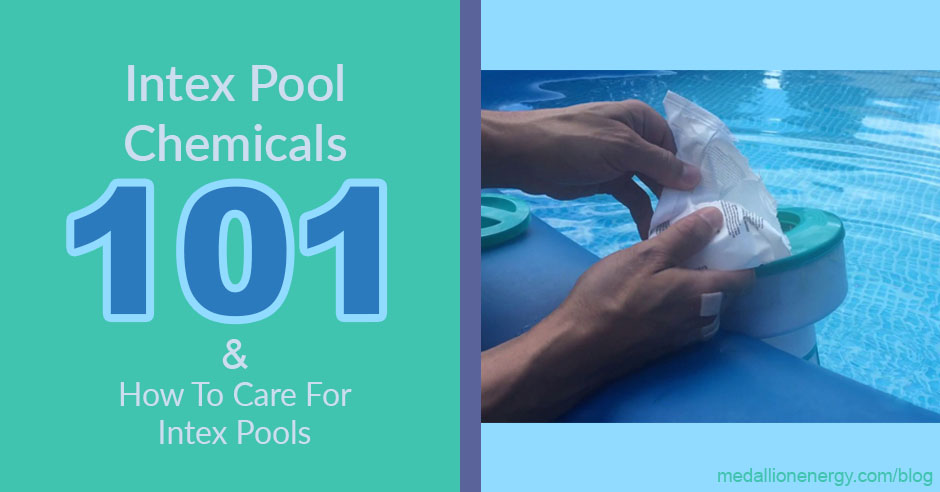Intex pools are the cost-effective alternative to permanent inground and above ground pools. They offer the full swimming pool experience, in a much simpler package.
At an average cost of less than $500, Intex pools are the perfect stepping stone for people interested in owning a pool, but not quite ready to make the purchase yet. And they come in a variety of shapes and sizes, from inflatable models to rectangular metal framed tanks.
If you own an Intex pool, it’s worth knowing that good maintenance and care goes a long way for extending the lifespan of your investment. And whether you’re setting up your Intex pool for the first time, or for the 5th summer in a row, adding the right chemicals is SUPER important.
Why?
Because good chemical care is the key to a long-lasting Intex pool. It keeps the surfaces of the pool frame clean and preserves the lining material. And it can be the difference between a pool that lasts 5 years, and one that breaks down at the end of the season.
So whether you need to know how to chlorinate an Intex pool, which chemicals to add, or how to care for one, this post is for you.
Wondering how much chlorine to add to your Intex pool? Trying to figure out how to put chemicals in the pool for the first time? Read this Intext Pool Chemical Startup Guide for all the answers.
Intex Pool Chemicals 101
How to put chemicals in your pool for the first time
While Intex pools aren’t the same as permanent swimming pools, they still require similar chemical maintenance. Not only for keeping the water germ-free and swimmers safe, but also to preserve the swimming pool itself.
Balanced water is gentle on pool surfaces and accessories, while unbalanced water is corrosive and breaks them down faster. This is why adding chemicals to your Intex swimming pool is so important.
That said, the process itself is fairly simple. You’ll need a pool water test kit (or strips) and a couple of startup chemicals. And you’ll find a list of those chemicals in the next section, so keep reading.
Intex Pool Startup Chemicals Guide
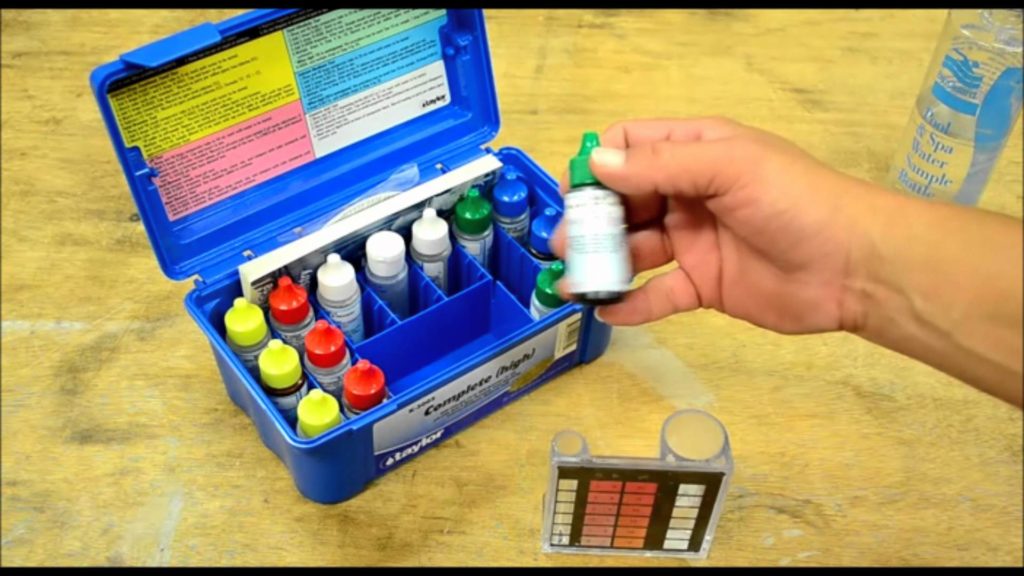


Adding opening chemicals to your Intex pool is a simple process that won’t take more than an hour or so. And while Intex pools do resist stains better than permanent pools, they’re not immune.
So to avoid dealing with green algae, cloudy water, or stains, take time to balance pool chemicals. Here are the chemicals you’ll need:
Intex Pool Chemical Startup List
- Alkalinity increaser (sodium bicarbonate)
- Alkalinity decreaser (sodium bisulfate)
- pH increaser (sodium carbonate)
- pH decreaser (sodium bisulfate)
- Calcium hardness increaser (calcium chloride)
- Sanitizer (liquid chlorine, chlorine tablets, Intex saltwater pool system)
- Cyanuric Acid/CYA (*if not included with chlorine)
- Algaecide
- Stain/scale remover
- Pool enzyme treatment
1.) Start with Total Alkalinity
While most startup pool chemical guides suggest starting with pH, we recommend balancing total alkalinity instead.
And here’s why: alkalinity is what stabilizes your pH.
Alkaline prevents your pH from fluctuating, which makes balancing your water MUCH easier. So by getting your Total Alkalinity levels right first, you’ll be able to adjust your pH faster.
Proper levels for Total Alkalinity range between 80 to 120 ppm.
To increase your water’s Total Alkalinity: Use an alkalinity increaser (also sold as sodium bicarbonate). Baking soda also works for increasing alkalinity, although it’s not as effective.
To decrease your water’s Total Alkalinity: Use an alkalinity decreaser (sodium bisulfate). In emergency situations, small doses of muriatic acid can also be used for lowering pH.
Once your alkalinity is within the 80-120 ppm range, it’s time to start adjusting pH.
2.) Adjust pH
pH measure how much of an acid or base a liquid is. The scale ranges from 0 to 14, with o being the most acidic, and 14 being the most basic. For reference, lemon juice is around a 2, while bleach sits at about 13.
Now, as far as your Intex pool’s pH is concerned, there’s a specific range to aim for.
The proper pH level for Intex swimming pools is between 7.4 – 7.6.
To increase your pool’s pH: Use a pH increase like sodium carbonate
To decrease your pool’s pH: Use a pH decreaser like sodium bisulfate
3.) Adjust Calcium Hardness
With your Total Alkalinity and pH levels in check, Calcium Hardness is the next chemical to adjust.
This chemical controls the literal “softness” or “hardness” of your water. Water with a calcium hardness level around 100 ppm will feel much silkier to the touch than water with levels over 400 ppm.
Ideal calcium hardness levels for Intex pools are between 100 and 300 ppm.
To increase your water’s calcium hardness: Use calcium increaser, also known as calcium chloride
To decrease your water’s calcium hardness: Dilute the water, no chemicals involved here. The most effective way to decrease calcium hardness is to physically remove the calcium. And the only way to do that is by diluting your water.
4.) Chlorinating an Intex pool
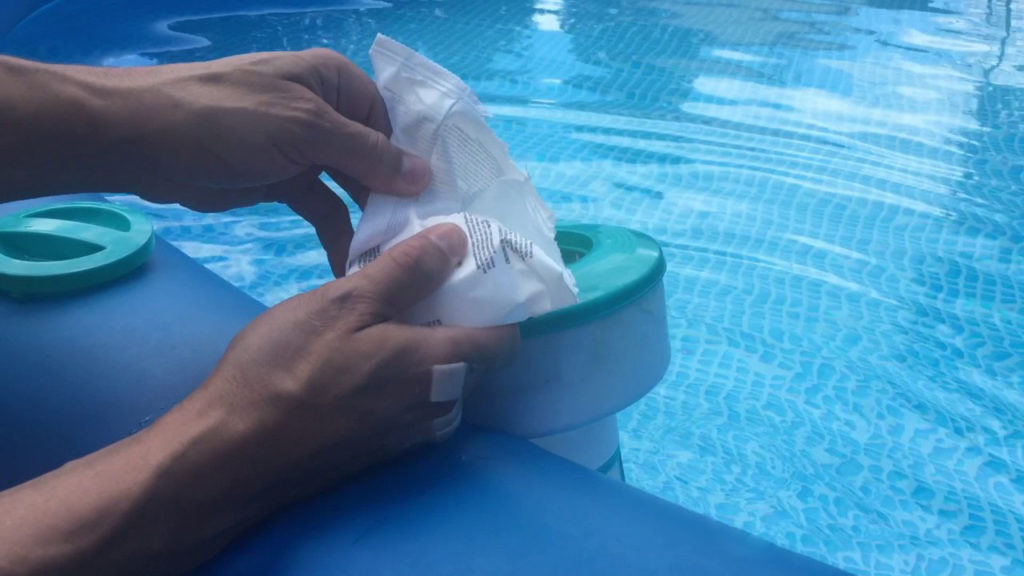


With all of your other chemicals in balance, the next step is handling the pool’s sanitizing needs. Most pool owners resort to the traditional chlorine bleach approach. But that’s not the only way to chlorinate your water.
The best way to chlorinate an Intex pool is with an Intex salt water pool system.
Why?
Because it does all the work for you. It produces the chlorine automatically. It adds the chlorine to your water when it needs it. And it keeps on doing it.
Plus, the chlorine from salt water pool systems is generally less harsh than traditional chlorine bleach. This is because salt water chlorination systems only use, well salt, to produce the chlorine. So with fewer chemicals involved, the result is “cleaner” and gentler chlorine.
But if a saltwater system isn’t an option right now, then you still have a few choices.
How much chlorine do I add to an Intex pool?
Add enough chlorine to raise your Free Chlorine levels to at least 3 ppm.
You can do this with:
- Pool shock
- Liquid chlorine
- Granular chlorine
- Chlorine tabs
For the best results, follow the instructions on the packaging. But overall, a cup, 3 tabs, or 1 shock treatment is a good place to start.
If you’re using chlorine tabs, put them in a floating chlorine tablet dispenser.
IMPORTANT: Make note of whether or not your chlorine products contain CYA, or cyanuric acid. This chemical is a chlorine stabilizer, and helps to extend the life of your chlorine. That said, too much of it can have a reverse effect and lock up your chlorine, so keep track of any CYA added to your water. Use your test kit if you’re unsure.
5.) Adding CYA to stabilize chlorine
CYA, or chlorine stabilizer, helps protect chlorine from sun damage so it lasts longer. This means a cleaner pool and less frequent chlorine replacements.
Most chlorine treatments come with CYA mixed in already, as it’s an essential chemical for effective sanitization. Without it, most of your chlorine would be gone within minutes.
But, CYA is also somewhat of a double-edged sword. Too little CYA and your chlorine won’t be protected from burning away. Too much of it, and you won’t be able to adjust chlorine at all.
With that said, the best CYA level for Intex pools is between 40-50 ppm.
To increase your water’s cyanuric acid level: Add cya, or CYA enhanced chorine
To decrease your water’s CYA: Sorry folks, you’ll have to dilute your water again. CYA is a chemical that isn’t easy to get rid of until it’s used up. So for the sake of time, diluting your water is the fastest solution.
To dilute your water: Empty out about 6 inches of water. Replace it with fresh water from a hose (use a hose pre-filter for the best results). Test, and repeat until CYA is lowered and within the proper range.
Related: Understanding How Cyanuric Acid (CYA) Affects Chlorine
6.) Finish with algaecide and stain remover
At this point, your Intex pool is balanced and ready for swimmers. But if you want to safeguard your investment, and protect yourself from cloudy water, pool stains, and algae, then these next few steps are worth every minute of effort.
To prevent pool algae from forming: Use an algaecide treatment every other week, and keep your water balanced
To prevent pool stains: Use a stain remover or enzyme treatment monthly, and install a metal collator in your skimmer.
To prevent cloudy water: Add DE powder to your pool filter and use a clarifier for more effective filtration. Also, keep your water balanced.
Related: Fix a Green Pool in 5 Easy Steps
How to care for Intex Pools
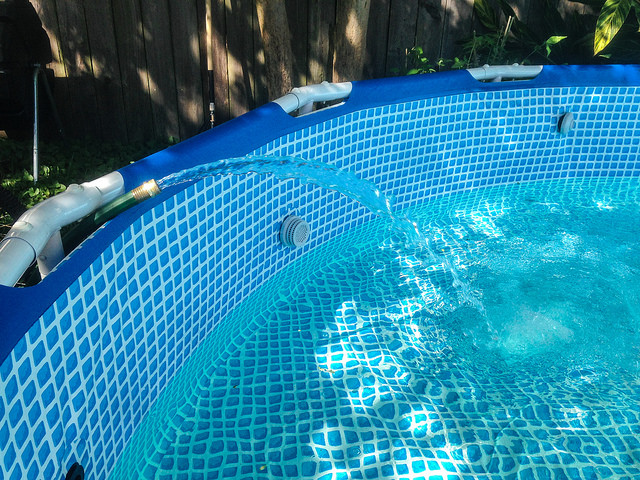


With your Intex pool water clean and balanced, half of your pool care work is out of the way. The rest of the job is keeping your pool clean and balanced.
Here are a few must-have accessories for Intex pool care:
- Telescopic pole
- Skimmer attachment
- Brush attachment
- Vacuum hose
- Vacuum head
- Pool chemicals (listed above)
1.) Clean your water
Cleaning your Intex pool breaks up into 3 main tasks:
- Skim the water at least 2 twice a week to clear out leaves and other surface debris
- Brush the inner walls and surfaces of the pool at least once a week to prevent buildup
- Vacuum the pool floor at least twice a week to keep the pool floor clean
(Since Intex pools don’t have main drains like in-ground pools do, they tend to collect floor debris faster. Many pool owners use automatic pool cleaners to help supplement main drains)
For the cleanest water, remember to clean out your pool filter at least once a month. This ensures the best performance and energy efficiency.
2.) Test weekly
If you want to keep your water balanced while spending the least on chemicals, test often. When you test your water regularly, you only need to make a few small adjustments to keep everything in order.
But if you wait too long in between testing, your pool chemistry will fluctuate more. And the more out of balance your water is, the more chemicals you’ll need to fix it.
So test often to keep chemical demand to a minimum.
We recommend using a pool test kit for water testing.
3.) Shock weekly
Even if you’re regularly testing and cleaning your water, it’s still a good idea to shock the pool each week. And unless you’re adding chlorine every single day, odds are your water can use the chlorine boost by the end of the week.
A few good reasons to shock your Intex pool:
- Keeps your sanitizer (chlorine) level in a healthy range
- Helps compensate for the effects of rainstorms
- Fends off algae and stains
It’s also a good idea to shock your water after big swim sessions or pool parties. That’s when your chlorine is at it’s lowest and working the hardest.
4.) Circulate your water
While cleaning your pool and balancing your water is a must, there’s nothing as important as good water circulation. It’s what makes your pool a swimming pool, and not a backyard swamp.
And it’s all thanks to your pool pump.
As your pool pump runs, it cycles all of the water in your pool. This does a few things:
- Spreads pool chemicals evenly
- Powers the filtration process
- Assists the pool heating process
- Prevents water from becoming stagnant
For the best results, run your Intex pool pump at least 8 hours a day. And for the best energy efficiency, run it at night.
This ensures that your water is properly circulated, filtered, and chemically balanced.
Heating your Intex pool
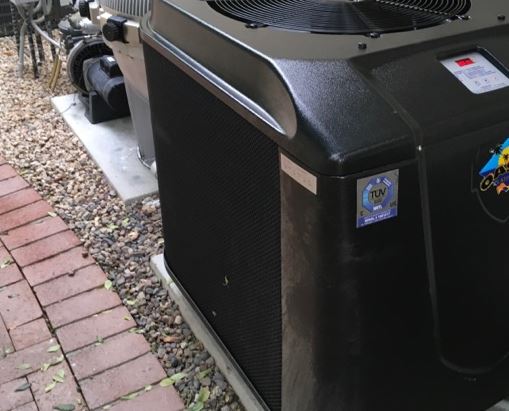


Warming up the water in your Intex pool is easier than you might think. Although options like gas heaters aren’t suitable, there are plenty of great alternatives.
Since Intex pools are MUCH smaller than inground and permanent above ground pools, they’re more affordable to heat.
The best ways to heat Intex pools are:
- Pool heat pumps
- Solar heaters
- Using a solar cover w/your heater
- Black garden hose (DIY pool heater)
Related: 7 Cheap Ways To Heat Your Pool
If you liked this post, you might also like:

